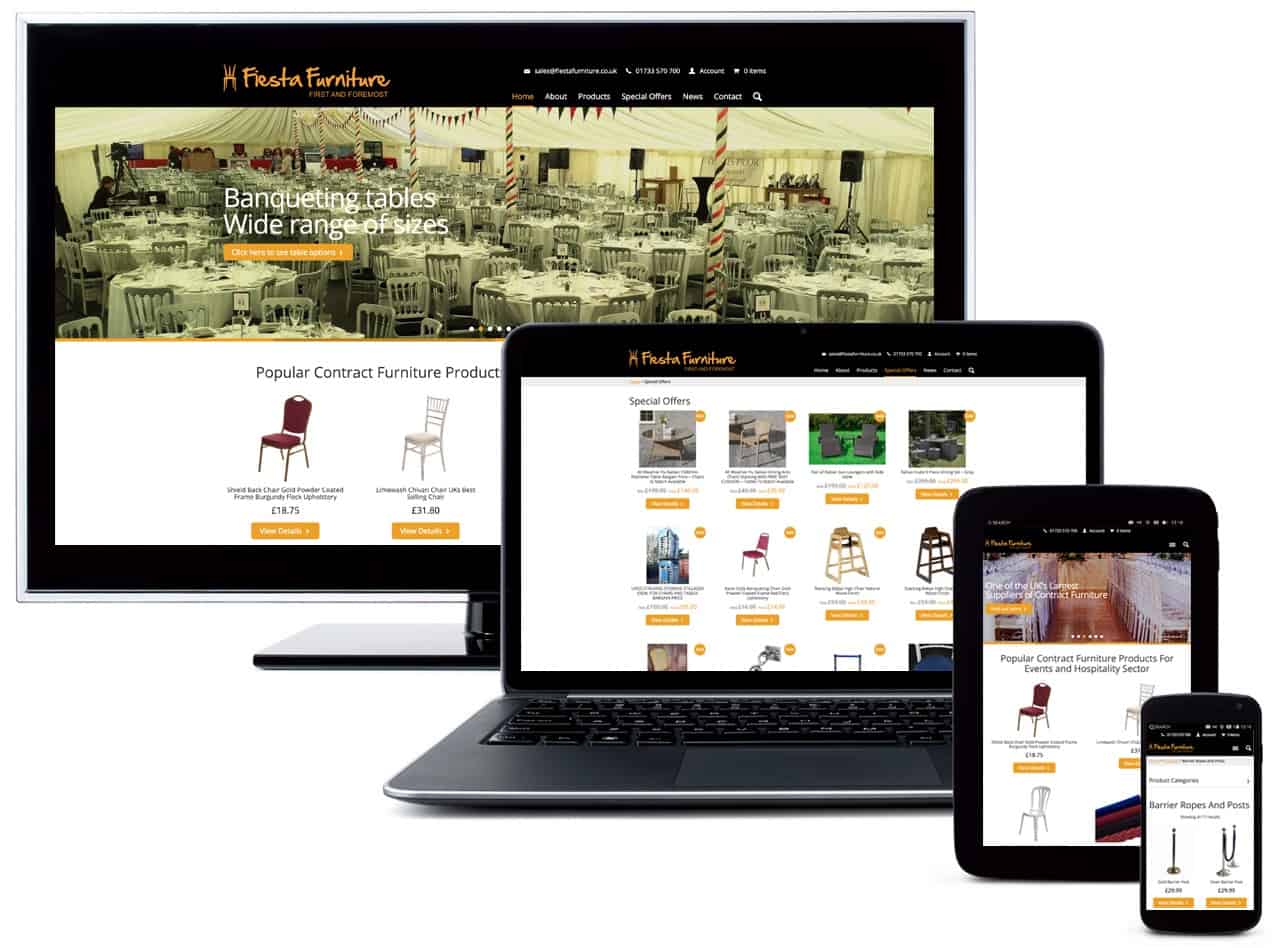Rationale
Fiesta Furniture was a leading manufacturer and supplier of quality contract furniture to the hotel, restaurant, leisure and care home industries; being the preferred contract furniture supplier to many of the leading names in the hospitality industry
With an increasing product range and opportunities for supplying new markets the old website was difficult to update, and not an accurate reflection of the companies capabilities.
Blue Dolphin bring the perfect mixture of analytics, creativity and getting stuff done. From the website through to email marketing we can rely on Blue Dolphin to get it sorted
Charles Lowry – Managing Director

Project Specification
- Design and build WordPress website featuring WooCommerce
- Integration of Stripe payment gateway
- Content creation and addition to site
- Pop up on exit for first time visitor
- Promotional popup
- Produce optimised news content to complement adwords
Key Benefits
- Improved site design and layout
- Ability to capture visitor information
- Implemented ongoing changes to “delivery” arrangements as shipping issues identified
- Improved organic ranking
- Really simple content management system allows Fiesta Furniture to easily change and add new information
- Linked with Mailchimp email campaigns
- Click here for more information on WordPress WooCommerce websites
Ecommerce Shipping Issues
Fiesta Furniture faced the challenge of shipping larger goods throughout the entire UK, including remote areas like the Scottish Islands, which posed various challenges for the ecommerce site. Here are some shipping issues they faced:
- Higher Shipping Costs: Shipping larger goods requires more space and often specialised handling. This can result in higher shipping costs, which might deter customers or reduce the competitiveness of the product.
- Limited Carriers: Not all carriers are equipped to handle large and heavy items, especially when delivering to remote locations. Ecommerce sites might have limited options for carriers, which could affect delivery times and cost.
- Complex Logistics: Shipping larger goods might involve complex logistics, including coordinating multiple carriers, transport modes, and handling equipment. This complexity can increase the chances of errors and delays.
- Delivery Timeframes: Delivering to remote areas such as the Scottish Islands can lead to longer delivery times due to the need for multiple transportation modes (trucks, ferries, etc.) and potential weather-related delays.
- Customs and Duties: For cross-border shipping within the UK, including to the Scottish Islands, customs and duties might apply. Ecommerce sites need to ensure proper documentation and compliance with regulations, which can be time-consuming.
- Packaging Challenges: Shipping larger goods requires suitable packaging to protect the items during transit. Finding the right packaging materials that ensure the safety of the items while minimising excess weight can be challenging.
- Address Verification: Remote locations might have unconventional or less standardised addressing systems. This can lead to address verification difficulties and potential delivery errors.
- Returns and Exchanges: Managing returns and exchanges for larger goods can be more complicated than smaller items. Ecommerce sites need to have clear policies in place for returning and replacing these items.
- Customer Expectations: Customers expect transparency in shipping costs, delivery times, and tracking information. Meeting these expectations for larger goods can be challenging, particularly in remote areas.
- Customer Service: Dealing with customer inquiries, complaints, and issues related to shipping, especially if there are delays or problems with larger goods, requires efficient and responsive customer service.
- Fragility and Damage: Larger goods might be more prone to damage during transit, especially if not handled properly. Ecommerce sites need to ensure proper handling instructions and partner with carriers experienced in transporting delicate or large items.
- Environmental Concerns: Shipping larger goods can have a higher environmental impact due to increased fuel consumption and emissions. Ecommerce sites might face pressure to adopt more sustainable shipping practices.
To address these challenges, ecommerce sites can consider strategies such as negotiating with carriers for specialised rates, investing in robust logistics management systems, offering clear shipping information to customers, optimising packaging for both safety and weight considerations, and setting realistic delivery expectations for remote areas.
Fiesta Furniture Issues Faced with Configurable Products
Configurable products, where customers can customise various attributes of a product before purchasing, can add complexity to an e-commerce site. Here are some ways an e-commerce site can cope with configurable products effectively:
- Clear Product Pages: Provide detailed and clear product pages with images, descriptions, and a user-friendly interface that allows customers to understand the available options and how they affect the final product.
- Customisation Options: Offer a user-friendly customisation interface that allows customers to select different attributes such as size, colour, material, etc. Use dropdowns, colour pickers, checkboxes, and other interactive elements to simplify the customisation process.
- Dynamic Pricing: Ensure that the price of the product dynamically adjusts based on the selected options. This prevents confusion and provides transparency about how each customisation impacts the final cost.
- Real-time Visualisation: If feasible, incorporate real-time product visualisation tools that show customers how their choices affect the appearance of the product. This could be done through visual previews or even 3D models.
- User-Friendly Navigation: Make it easy for customers to find configurable products by categorising them appropriately and using clear filters. This helps customers narrow down their choices quickly.
- Advanced Search and Filtering: Implement advanced search and filtering options that allow customers to find products based on specific attributes. This can be especially helpful if you have a wide range of configurable products.
- Responsive Design: Ensure that your website is responsive and works well on different devices, including desktops, tablets, and smartphones. Customisation options should be easy to use on all screen sizes.
- Intuitive Checkout: Keep the checkout process simple and intuitive. Provide a clear summary of the selected customisation options before customers proceed to checkout.
- Inventory Management: Manage your inventory effectively to ensure that the selected customisation options are in stock. Display real-time availability to prevent customers from selecting options that are out of stock.
- Clear Product Descriptions: Provide concise and accurate descriptions for each customisation option, so customers understand what they are choosing. Include any relevant information about materials, sizes, and benefits.
- Customer Reviews and Ratings: Display customer reviews and ratings specific to each configurable product. This can help potential buyers make informed decisions about their customisation choices.
- Easy Editing: Allow customers to easily edit their customisation choices during the shopping process. This can help reduce frustration if they change their mind or make a mistake.
- Responsive Customer Support: Offer responsive customer support through various channels like live chat, email, or phone. Customers might have questions or concerns about customisation options.
- Order Summaries: Provide a detailed order summary at the end of the customisation process and before checkout. This gives customers a final chance to review their choices and make any necessary adjustments.
- Testing and User Feedback: Continuously test the customisation process and gather feedback from users. Use this feedback to make improvements and enhance the user experience.
- Performance Optimisation: Ensure that the website’s performance is not compromised due to the complexity of configurable products. Slow loading times or glitches can discourage customers from making purchases.
By implementing these strategies, you can provide a seamless and user-friendly experience for customers navigating and customising configurable products on your e-commerce site.















